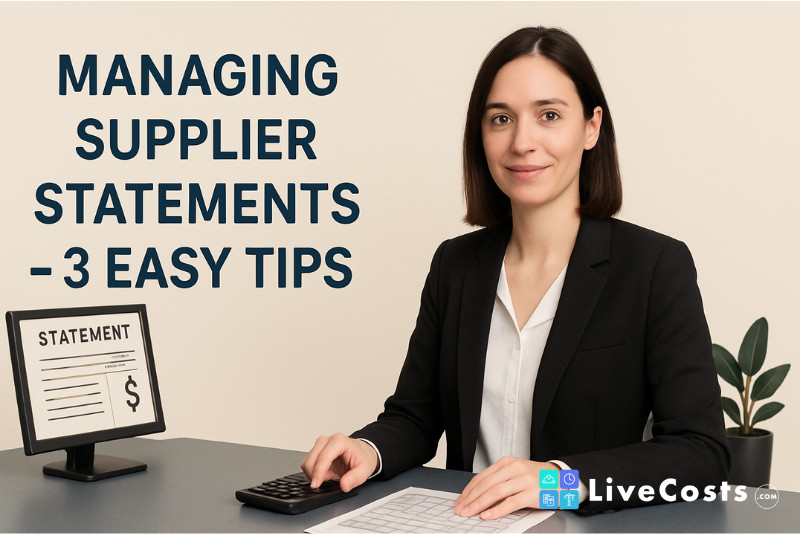A construction company will receive both invoices and a statement at the end of each month from their supplier. Let’s have a look at the differences between the two and some tips on managing supplier statements to make sure that they are correct.
An invoice is issued from a supplier to a buyer and is related to the specific transaction of materials. The purpose of an invoice is to receive payment from the buyer or to simply show evidence of sale of the materials.
A statement is a document which shows all items that have not yet been paid by the buyer. This statement reminds the buyer what they have to pay their supplier. Invoices can be issued every day and in large quantities, whereas statements are generally sent once a month. The AP team plays a crucial role in managing these statements to ensure timely payments.
Accurate data is essential in managing supplier statements, as it helps in cross-checking invoices and ensuring all transactions are correctly recorded.
Let’s take a look at some difficulties and solutions to managing statements.
Introduction to Supplier Statements
Supplier statements are essential documents provided by vendors that outline the transactions between the buyer and supplier over a specific period. These statements typically include details such as invoices, credit notes, payments, and balances, allowing businesses to track their financial interactions with suppliers.
The supplier statement reconciliation process involves comparing these statements with the company’s internal records, such as the purchase ledger, to ensure accuracy and identify any discrepancies. Effective management of supplier statements is crucial for maintaining healthy supplier relationships, preventing late payments, and making informed decisions about working capital.
By regularly reviewing and reconciling these statements, businesses can ensure that all transactions are accurately recorded and any issues are promptly addressed.
What is involved in managing supplier statements?
It can be considered an essential aspect for Accounts Payable to check all invoices that were received by the business. Its aim is to check for any missing invoices, duplicates, or overcharged payments and confirm that all payments and credit notes are included.
Dealing with discrepancies promptly is crucial to maintaining positive relationships and reducing the risk of errors in accounts. If all statements were to be reconciled effectively, then it would resolve any issues and ensure suppliers are paid on time.
Invoice Quantity
The amount of invoices that a construction company may receive is significant.
Trying to manage all of these invoices can cause difficulty for AP teams. If these invoices are not checked and categorised as they come in, it can lead to invoices not matching up with the statement at the end of the month and may result in an overpayment.
Maintaining accurate ledgers is crucial for identifying discrepancies between purchase ledgers and supplier statements, which supports timely payments and better financial management.
This stress can be reduced by organising these invoices by date and checking how much has been charged, as the invoices are coming in. This way, invoices should match their supplier statement at the end of each month.
Balance brought forward
Invoices won’t always match the statement at the end of each month. This can sometimes be because of an overpayment but it can also be because of a forgotten about balance from the previous month or discrepancies in the financial statements.
If this was not noted the previous month, it can lead to confusion and an effort to search for where this payment is coming from. It is essential to then make a record of any underpayments, this way the business will not be shocked or surprised when they have to pay more the next month.
Identifying and resolving errors is crucial to maintain accurate financial records and supplier relationships.
Prioritising statements
Having to manage day to day activities does not often leave a lot of free time to reconcile invoices and statements. It would be ideal to first reconcile large supplier invoices as these will be more expensive, meaning that any discrepancy or overpayment will likely be for a higher amount.
Finding mistakes from bills that are statements that are more expensive will mean a higher retention of profit. If all statements can be reconciled effectively that would be even better, an efficient way to do this would be integrating the use of software that will notify the business of any discrepancies in their invoices or statements within the ERP system.
Automation can improve efficiency, reduce errors, and save time for the Accounts Payable team, allowing them to manage larger volumes more effectively and enhance accuracy in supplier relationship management.
LiveCosts uses AI invoice automation, purchase order tracking and delivery management which instantly notifies you of any discrepancies such as overpayments, incorrect orders and damaged materials arriving on site. Save money and time, there’s no longer a need to spend hours sorting through invoices to endure you’ve paid no more than you were meant to.
What is involved in managing supplier statements?
Statement reconciliation is a critical process for businesses, particularly for accounts payable teams. It involves comparing supplier statements with internal records to identify discrepancies, missing invoices, or further errors. The reconciliation process helps to prevent errors, reduce late payments, and maximise early payment discounts.
By ensuring the accuracy of financial records, businesses can make more informed decisions about their financial operations. Moreover, statement reconciliation is essential for maintaining a positive relationship with suppliers, as it demonstrates a commitment to timely and accurate payments.
The accounts payable team plays a vital role in this process, as they are responsible for reconciling supplier statements and resolving any discrepancies that may arise. This diligent approach not only safeguards the company’s finances but also fosters trust and reliability with suppliers.
Tools and Resources for Efficient Management
Automated supplier statement reconciliation software can significantly improve the efficiency of the reconciliation process. These tools can help accounts payable teams to quickly and accurately match supplier statements with internal records, identify discrepancies, and resolve errors. By automating the reconciliation process, businesses can save time, reduce manual errors, and improve the overall accuracy of their financial records.
Additionally, ERP systems can provide a centralized platform for managing supplier statements, invoices, and payments, making it easier for businesses to track their financial interactions with suppliers. Other tools and resources, such as document management software and online portals, can also support the reconciliation process by providing a secure and efficient way to store and share documents.
Leveraging these technologies can streamline operations and enhance the overall efficiency of the accounts payable team.
Conclusion and Next Steps
In conclusion, supplier statement reconciliation is a critical process for businesses that requires careful attention to detail and efficient management. By implementing automated supplier statement reconciliation software and utilising tools and resources such as ERP systems and document management software, businesses can improve the accuracy and efficiency of their reconciliation process. To take the next step, businesses should consider the following key steps:
(1) review their current reconciliation process to identify areas for improvement,
(2) research and implement automated supplier statement reconciliation software, and
(3) provide training and support to accounts payable teams to ensure they are equipped to manage the reconciliation process effectively.
By following these steps, businesses can improve their financial operations, reduce errors, and maintain healthy supplier relationships. Furthermore, businesses can also consider outsourcing their supplier statement reconciliation process to a third-party provider, such as a recovery auditor, to help identify and recover missing credits, discounts, and other financial benefits. This proactive approach will ensure that the reconciliation process is thorough and that the company’s financial health is maintained.
Learn more about LiveCosts

Written By :
Niall Brennan
Product Manager & Founder @Livecosts.com



